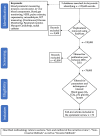Real-Time Monitoring of Blood Parameters in the Intensive Care Unit: State-of-the-Art and Perspectives
- PMID: 35566534
- PMCID: PMC9100654
- DOI: 10.3390/jcm11092408
Real-Time Monitoring of Blood Parameters in the Intensive Care Unit: State-of-the-Art and Perspectives
Abstract
The number of patients in intensive care units has increased over the past years. Critically ill patients are treated with a real time support of the instruments that offer monitoring of relevant blood parameters. These parameters include blood gases, lactate, and glucose, as well as pH and temperature. Considering the COVID-19 pandemic, continuous management of dynamic deteriorating parameters in patients is more relevant than ever before. This narrative review aims to summarize the currently available literature regarding real-time monitoring of blood parameters in intensive care. Both, invasive and non-invasive methods are described in detail and discussed in terms of general advantages and disadvantages particularly in context of their use in different medical fields but especially in critical care. The objective is to explicate both, well-known and frequently used as well as relatively unknown devices. Furtehrmore, potential future direction in research and development of realtime sensor systems are discussed. Therefore, the discussion section provides a brief description of current developments in biosensing with special emphasis on their technical implementation. In connection with these developments, the authors focus on different electrochemical approaches to invasive and non-invasive measurements in vivo.
Keywords: blood parameters; critical care; electrochemistry; intensive care; monitoring.
Conflict of interest statement
The authors declare no conflict of interest regarding the content of this review. L.B., M.B.M., L.H., B.I., G.C., S.B. and P.M.S. submitted a patent named “Smart catheter for blood parameter sensing” (AZ 10 2021 120 410.0).
Figures



Similar articles
-
Glucose control in the intensive care unit.Crit Care Med. 2009 May;37(5):1769-76. doi: 10.1097/CCM.0b013e3181a19ceb. Crit Care Med. 2009. PMID: 19325461 Review.
-
Surgical intensive care - current and future challenges?Qatar Med J. 2020 Jan 13;2019(2):3. doi: 10.5339/qmj.2019.qccc.3. eCollection 2019. Qatar Med J. 2020. PMID: 31976309 Free PMC article.
-
Critical Care Network in the State of Qatar.Qatar Med J. 2019 Nov 7;2019(2):2. doi: 10.5339/qmj.2019.qccc.2. eCollection 2019. Qatar Med J. 2019. PMID: 31763205 Free PMC article.
-
[A Chinese consensus statement on the clinical application of transesophageal echocardiography for critical care (2019)].Zhonghua Nei Ke Za Zhi. 2019 Dec 1;58(12):869-882. doi: 10.3760/cma.j.issn.0578-1426.2019.12.002. Zhonghua Nei Ke Za Zhi. 2019. PMID: 31775449 Chinese.
-
Electrochemical sensors for continuous monitoring during surgery and intensive care.Acta Anaesthesiol Scand Suppl. 1995;104:15-9. doi: 10.1111/j.1399-6576.1995.tb04251.x. Acta Anaesthesiol Scand Suppl. 1995. PMID: 7660746 Review.
Cited by
-
Ultrasonography in the intensive care unit: a bibliometrics analysis.J Thorac Dis. 2024 Jan 30;16(1):623-631. doi: 10.21037/jtd-23-1190. Epub 2024 Jan 15. J Thorac Dis. 2024. PMID: 38410606 Free PMC article.
-
Lactate Monitoring in Intensive Care: A Comprehensive Review of Its Utility and Interpretation.Cureus. 2024 Aug 7;16(8):e66356. doi: 10.7759/cureus.66356. eCollection 2024 Aug. Cureus. 2024. PMID: 39246930 Free PMC article. Review.
-
Patent landscape review of non-invasive medical sensors for continuous monitoring of blood pressure and their validation in critical care practice.Front Med (Lausanne). 2023 Jul 11;10:1138051. doi: 10.3389/fmed.2023.1138051. eCollection 2023. Front Med (Lausanne). 2023. PMID: 37497278 Free PMC article. Review.
References
-
- Statistische Bundesamt (Destatis) Zahl der Intensivbetten in Deutschland von 1991 bis 2018. 2021. [(accessed on 13 April 2021)]. Available online: https://www.destatis.de/DE/Presse/Pressemitteilungen/2020/10/PD20_N064_2....
-
- Bellani G., Laffey J.G., Pham T., Fan E., Brochard L., Esteban A., Gattinoni L., van Haren F., Larsson A., McAuley D.F., et al. Epidemiology, Patterns of Care, and Mortality for Patients with Acute Respiratory Distress Syndrome in Intensive Care Units in 50 Countries. JAMA. 2016;315:788–800. doi: 10.1001/jama.2016.0291. - DOI - PubMed
-
- EuroELSO EuroELSO Survey on ECMO Use in Adult COVID-19 Patients in Europe. [(accessed on 16 March 2021)]. Available online: https://www.euroelso.net/covid-19/covid-19-survey/
Publication types
Grants and funding
LinkOut - more resources
Full Text Sources
Miscellaneous

